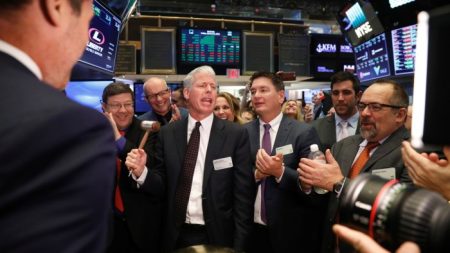Unlock the Editor’s Digest for free
Roula Khalaf, Editor of the FT, selects her favourite stories in this weekly newsletter.
Shares in Arm rocketed by more than 50 per cent on Thursday after the UK chip designer reported higher royalty and licensing revenue boosted by strong AI demand.
Chief executive Rene Haas said during Wednesday’s results that Arm had benefited from the “profound opportunity” brought by the demand for new artificial intelligence applications being deployed by tech companies.
Arm, which offers the foundational architecture behind chips, raised its earnings outlook as it doubled down on its claim that a revolutionary shift in demand for AI computing power will drive the next phase of its growth.
The company’s revenue in the three months to the end of December was $824mn, up 14 per cent year on year, above consensus estimates of $763mn, according to S&P Capital IQ. Arm also revised higher its full-year revenue guidance from a range of $2.96bn-$3.1bn to $3.15bn-$3.2bn.
Arm said that royalty revenue from smartphones had also improved, thanks to a recovery in device sales.
Adjusted earnings per share were $0.29, and it lifted its full-year guidance from a range of $1.00-$1.10 to $1.20-$1.24.
It is Arm’s second quarterly earnings report since going public in September. Its first report had left Wall Street underwhelmed, as it paid out more than $500mn in remuneration costs following the listing in New York, which required it to settle shares previously granted to employees.
Japan’s SoftBank holds more than 90 per cent of shares in Arm, after acquiring the business for $32bn in 2016. The UK had lobbied hard for Cambridge-based Arm to list in London, but SoftBank opted instead for New York, believing it had a better chance of recouping its investment with Arm trading alongside high-valued US tech companies.
Arm shares traded at almost $120 on Thursday morning in New York, more than double the $51 price the company offered when it first listed.
On an earnings call following the results announcement, Haas said that Arm was “the most fundamental, pervasive compute platform in the history of digital design”, with demand for AI applications “driving the need for a lot of different products”.
Royalties from Arm’s newest Armv9 chip design architecture, which is embedded in devices powering AI applications, now make up 15 per cent of the company’s overall royalty revenues, up from 10 per cent during the last quarter. It is bringing twice the royalty rate of the previous Armv8 designs, Haas said.
Processor chips in data centres that train large language models, including Nvidia’s Grace Hopper, Microsoft’s Cobalt and Amazon’s Graviton, are all based on Arm’s V9 architecture. Similarly, Arm’s V9 designs were “in all of the premium smartphones” released by the likes of Apple, Samsung and Google, Haas said.
The company also experienced strong growth in China, Arm chief financial officer Jason Child said. Arm China now accounts for 25 per cent of total revenue, up from 20 per cent for the prior quarter.
Licensing revenue growth also increased, thanks in part to an uptick in demand for its computing platform, Arm Total Access, Haas said.
Arm’s upbeat results contrast with several other chip companies that have reported this year, with Intel, AMD and Texas Instruments all offering more tepid outlooks amid concerns about broader sluggishness in the semiconductor sector.
Qualcomm, however, also beat revenue expectations last week, which it credited to demand for AI-focused chips.
Read the full article here














